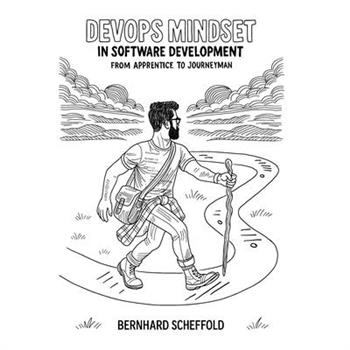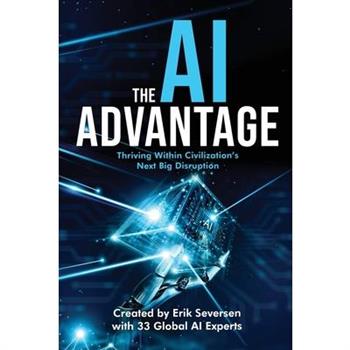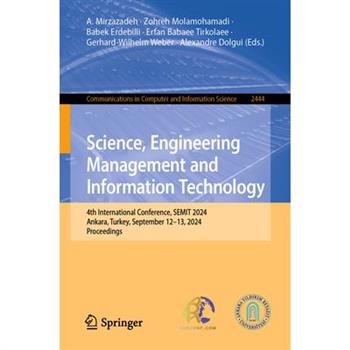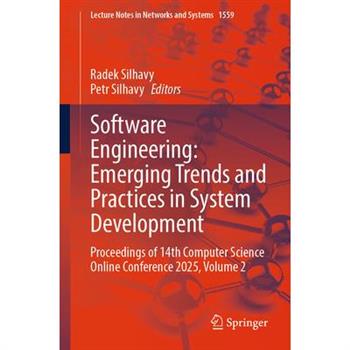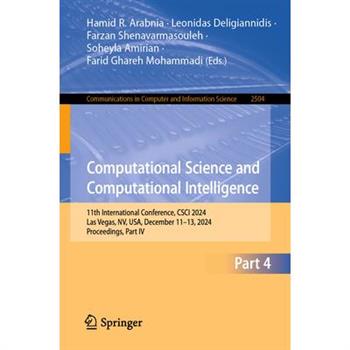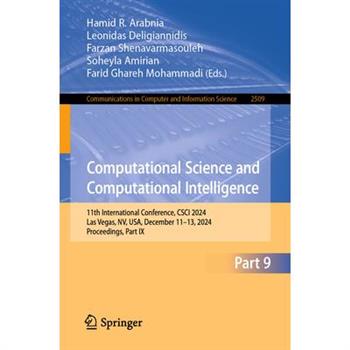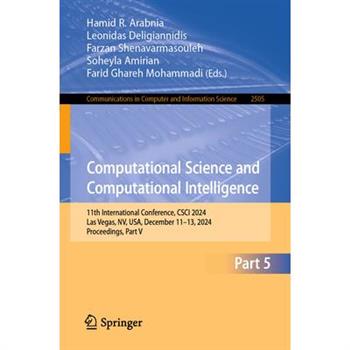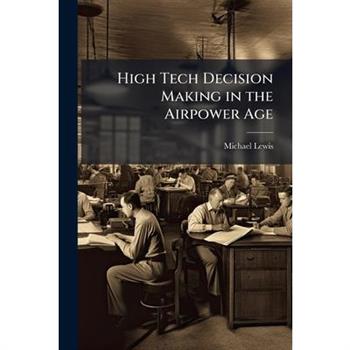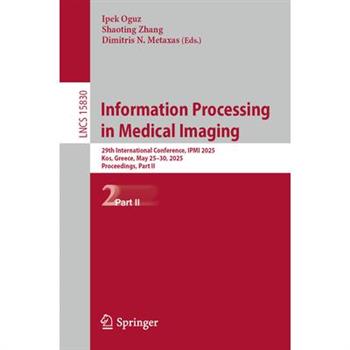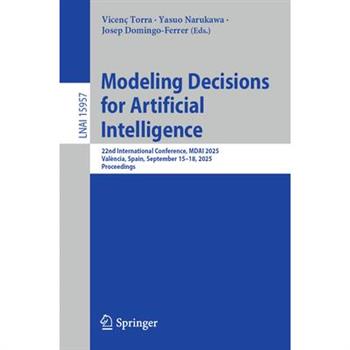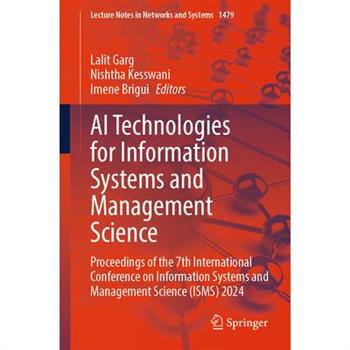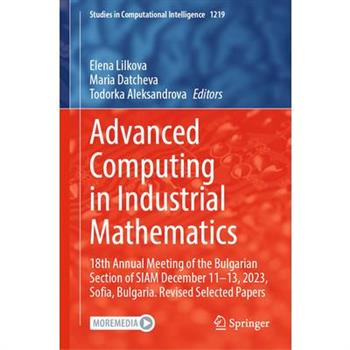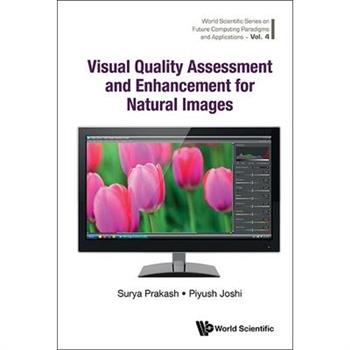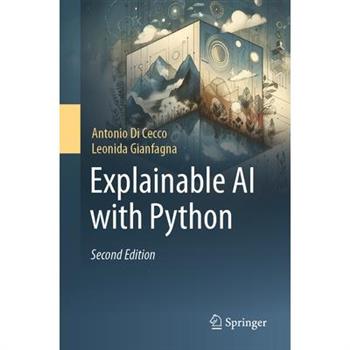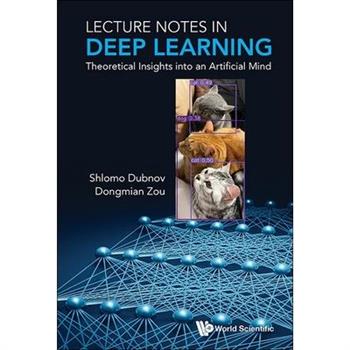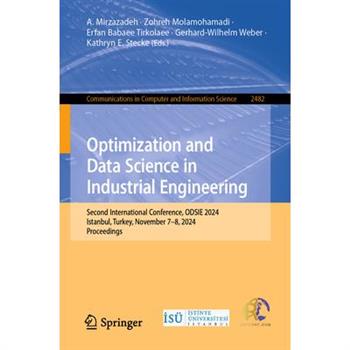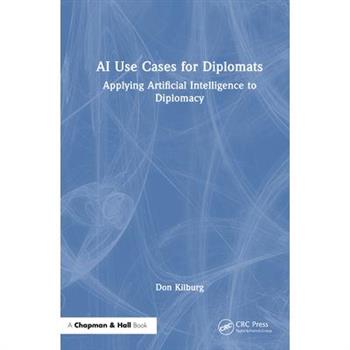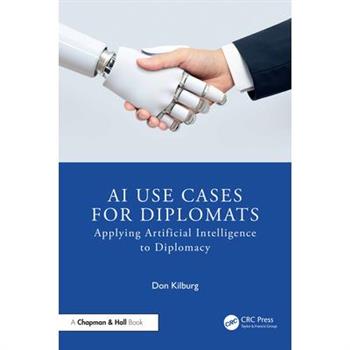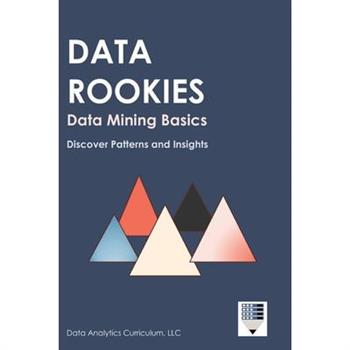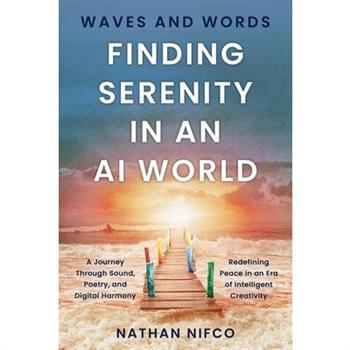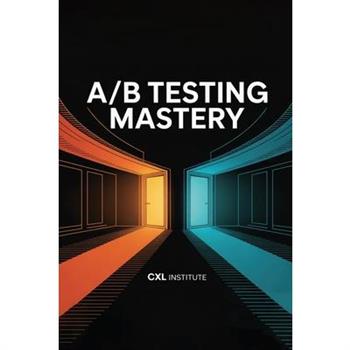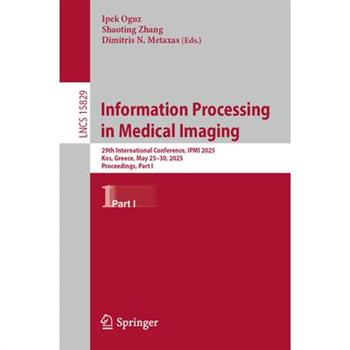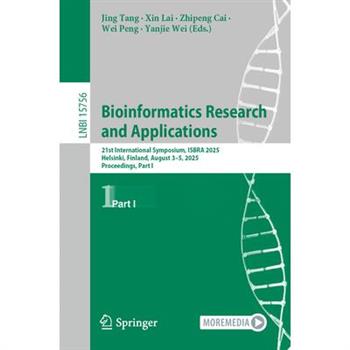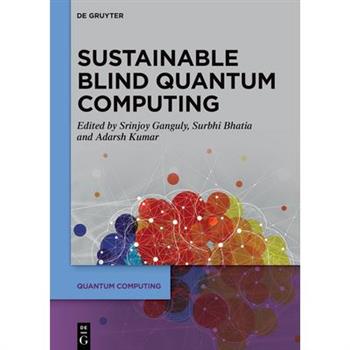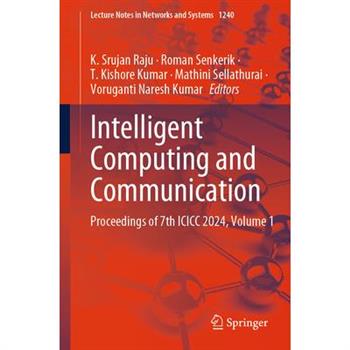DevOps Mindset in Software Development
In a world where delivering real value through software feels like chasing a moving target, this book challenges you to rethink how software is built-and why so many teams still struggle.Drawing on 30 years of experience, "DevOps Mindset" exposes the pitfalls of "silver bullet" promises and outdated paradigms that stall true progress. With practical insights and real-world lessons, you'll discover how to bridge the gap between delivering software and delivering results. Whether you're a developer in the trenches or a project leader navigating complex team and supplier dynamics, this book offers actionable strategies to create value for your customers while transforming the often-misunderstood role of "DevOps" into a catalyst for cultural and business growth.It's time to stop the struggle and start building software that truly delivers. Are you ready to take the first step from apprentice to journeyman?
The AI Advantage
Artificial Intelligence is no longer science fiction. It is here!Will you use AI to your advantage or will you fall behind?For decades, artificial intelligence has captured the human imagination-from sentient machines in science fiction to real-world breakthroughs that now shape our everyday lives. The AI Advantage offers readers a practical guide to understanding and using AI in a world that is rapidly transforming.This book, written by a team of AI experts from diverse fields including business, healthcare, education, cybersecurity, creative arts, and more, gives readers the clarity needed to thrive in the age of intelligent machines.The AI Advantage is a blueprint for personal and professional growth. Each chapter explores how AI tools are already reshaping industries, automating tasks, unlocking new creative possibilities, and enhancing decision-making. Whether you're a manager, entrepreneur, educator, student, or simply curious about what AI means for your life, this book helps you get started using AI tools that increase productivity, spark innovation, and create meaningful advantage in your work and daily routines.At a time when hype and fear often dominate the conversation around artificial intelligence, The AI Advantage offers a grounded, hopeful perspective. It doesn't promise utopia or predict doom-it gives you something far more valuable: a place to start.Discover what's possible, what's coming, and how to move forward with purpose in this new era. The AI Advantage is your invitation to stop watching the future happen-and start shaping it.The co-authors in this book include Heikki Almay, Nik Baker, Romit Bhatia, Sarah Choudhary, PhD, Pedro Clark Leite, Jingying Gao, PhD, Vivek Gnanavelu, Yuri Gubin, Julien Guille, Anil Hari, Ofer Hermoni, PhD, Maman Ibrahim, Anupriya Jain, Lydia James, Bridget Kovacs, Matt Kurleto, Arnaud Lucas, Samer Madfouni, Parul Malik, Nathaniel J. Melby, PhD, Kurt Mueller, Giorgio Natili, Lech Nowak, Rory O'Keeffe, Izak Oosthuizen, Elisa Phillips, Paul Powers, Gabriele Sangugino, Linda Sinisi, Greg Starling, Jodessiah Sumpter, Sakina Syed, and Ersin Uzun, PhD.
STEM and AI for Everyone
What if STEM and AI felt less like a syllabus and more like a story you could step into?Follow teacher Lila, tech coach Mia, and a cast of big-hearted kids through a school year of tiny, doable adventures-robots that learn to stop at red squares, garden beds planned with block diagrams, pancakes that teach algorithms, rockets that obey guardrails, and a Halloween "hacker hunt" where the bravest sound is a kind, firm "no."Told in warm narrative and paired with practical "Try It Tomorrow" mini-guides, this book offers a blueprint for teaching STEM and AI that's joyful, safe, and deeply human. You'll find checklists, prompt "sandwiches," and privacy habits that turn AI into a coach-not a cheat-and simple rituals that make fairness, access, and care part of every lesson.Whether you're a primary teacher, a parent at the kitchen table, or a community leader with a stack of pizza boxes and big hopes, this is your pocket companion for building guardrails-and the confidence to be glorious inside them.
Research Perspectives on Software Engineering and Systems Design
This book offers a broad range of ideas from CoMeSySo 2024, highlighting theory and practice in modern computing. Researchers from diverse backgrounds present their latest findings on systems design, software engineering, and innovative problem-solving. Topics include new methods to improve modeling, testing, and optimization across various fields. This book also shows how data-driven approaches and well-structured architectures can increase reliability. These proceedings foster meaningful teamwork and shared learning by bringing together experts from many areas. Readers will gain insights into advanced techniques that can be adapted to real-world situations. Industry specialists, academic researchers, and students will benefit from the breadth of approaches. Case studies reveal common hurdles and present workable solutions for upcoming challenges. With a clear focus on advancement, this resource is an essential guide to the next steps in computational development.
Science, Engineering Management and Information Technology
This book constitutes selected papers presented at the the 4th International Conference on Science, Engineering Management and Information Technology, SEMIT 2024, held in Ankara, Turkey, during September 12-13, 2024. The 27 full papers included in this book were carefully reviewed and selected from 123 submissions. These papers were organized in the following topical sections: Advances of AI/ML and Optimization in IT and Engineering; Novel AI Techniques in Healthcare and Medicine; Digital Technologies for Customer Service Orientation and Social Sustainability; Applications of AI/ML/DL in Traffic and Transportation Engineering.
Software Engineering: Emerging Trends and Practices in System Development
This book discovers peer-reviewed research from an international research conference that unites experts in software engineering, data science, artificial intelligence, cybernetics, and informatics. This book presents cutting-edge methods, practical case studies, and foundational advances that address real-world challenges across the computational spectrum. Whether you seek rigorous theory, proven development practices, or visionary perspectives on emerging technologies, this book provides a comprehensive resource for researchers, practitioners, and students committed to shaping the future of digital systems.
Computational Science and Computational Intelligence
The CCIS book constitutes selected papers accepted in the Research Track on Education of the 11th International Conference on Computational Science and Computational Intelligence, CSCI 2024, which took place in Las Vegas, NV, USA, during December 11-13, 2024. The 26 full papers included in this book were carefully reviewed and selected from a total of 155 submissions. They were organized in topical sections on subject-specific education and curriculum design; education and artificial intelligence; teaching and learning strategies and related reserach studies.
Computational Science and Computational Intelligence
This CCIS book constitutes selected papers accepted in the Research Track on Big Data and Data Science and the Research Track on Social Network Analysis, Social Media and Mining held as part of the International Conference on Computational Science and Computational Intelligence, CSCI 2024, which took place in Las Vegas, NV, USA, during December 11-13, 2024. The Research Track on Big Data and Data Science, CSCI-RTBD, received 72 submissions of which 18 papers were accepted. For the Research Track on Social Network Analysis, Social Media and Mining, CSCI-RTNA, 7 papers were accepted from 41 submissions. They were organized in topical sections on Big Data and Data Science - applications and algorithms; Social Network Analysis, Social Media, and Mining; and Ongoing Research Projects and Posters.
Extended Reality
The seven-volume set LNCS 15737-15743 constitutes the proceedings of the International Conference on Extended Reality, XR Salento 2025, held in Otranto, Italy, during June 17-20, 2025.The 128 full papers presented together with 65 short papers were carefully reviewed and selected from 256 submissions. The papers are organized in the following topical sections: Part I: Virtual Reality; and Augmented and Mixed Reality.Part II: Extended Reality; and Extended Reality in Education and Learning.Part III: Transforming Research and Clinical Interventions with eXtended Reality.Part IV: Digital Twin: Innovative Approaches in Industry and Healthcare.Part V: eXtended Reality for Cultural Tourism Sustainability; eXtended Reality for Art, Design, and Entertainment; and Digital Twin and Smart Virtual Representations for Cultural Heritage.Part VI: Crafting Virtual Humans for Immersive XR Applications; and eXtended Reality for Serious Games.Part VII: Artificial Intelligence; Integrating Artificial Intelligence, Computer Vision and Augmented Reality in Computer-Assisted Intervention; and AI-Driven XR Innovations in Healthcare: Bridging Technology and Ethics.
Computational Science and Computational Intelligence
This CCIS book constitutes selected papers accepted in the Research Track on Smart Cities and Smart Mobility and the Research Track on Software Engineering of the 11th International Conference on Computational Science and Computational Intelligence, CSCI 2024, which took place in Las Vegas, NV, USA, during December 11-13, 2024. The Research Track on Smart Cities and Smart Mobility, CSCI-RTSC, received 75 submissions of which 15 papers were accepted. For the Research Track on Software Engineering, CSCI-RTSE, 13 papers were accepted from 58 submissions, 12 of these are included in this volume. They were organized in topical sections on Infrastructures: Smart Cities, Tools, and Utilities; Smart Cities and Smart Mobility; Software Engineering; and ongoing research projects.
Corsair's Code
Embark on an unparalleled voyage into the very essence of visual authenticity with "Corsair's Code: Composing Material Appearance for Photorealistic Rendered Forms." This groundbreaking exposition navigates the intricate seas of light-matter interaction, unlocking the secrets to crafting digital surfaces that defy distinction from reality. Beyond mere color, the true power of photorealism lies in mastering the nuanced dance of light across every pixel, a dance orchestrated by the meticulous composition of material appearance.Dive deep into the fundamental principles that govern how surfaces truly look. Unravel the mysteries of Bidirectional Reflectance Distribution Functions (BRDFs), the core mathematical constructs that define light reflection. Discover the subtle yet profound differences between diffuse and specular reflection, and grasp how microfacet theory illuminates the impact of surface roughness on light scattering. Essential to truly authentic reflections, the intricacies of Fresnel equations are meticulously demystified, providing the bedrock for accurate reflectivity across all viewing angles. This foundational knowledge is not just theoretical; it's the practical blueprint for physically plausible rendering results.The journey continues by exploring the artistry and engineering behind adding rich, intricate detail to your digital creations. Master the versatility of texturing techniques, from the raw power of image-based textures that capture real-world complexity to the dynamic flexibility of procedural textures that offer infinite resolution and algorithmic precision. Learn how to strategically combine these methods to achieve surfaces teeming with visual life and unparalleled realism, transforming barren geometries into compelling, detailed forms.Beyond the basics, this comprehensive guide propels you into the realm of complex material models. Confront the challenges of layered materials, where multiple finishes interact to create sophisticated effects like coated metals or varnished wood. Delve into the fascinating world of translucent materials, understanding the phenomena of subsurface scattering that gives life to skin, wax, and jade. Explore the enigmatic beauty of anisotropic materials, where light reflects differently based on direction, essential for rendering brushed metals, velvet, or hair with breathtaking accuracy. This section unlocks advanced rendering capabilities, enabling the simulation of light's most intricate interactions.The mastery of material appearance culminates in its seamless integration with the very algorithms that bring scenes to life. Explore the symbiotic relationship between advanced material models and rendering algorithms. Gain a profound understanding of how path tracing intricately interacts with material properties to yield stunningly realistic images. Discover vital ray tracing optimization techniques, including acceleration structures, to dramatically enhance rendering performance without compromising visual fidelity. Delve into sophisticated material sampling strategies, critical for efficiently processing even the most complex BRDFs, ensuring your scenes render with both speed and impeccable accuracy."Corsair's Code" is more than a book; it's your compass and chart through the complex currents of photorealistic material composition. It equips you with the fundamental understanding, the advanced techniques, and the forward-thinking insights required to sculpt light and surface into unparalleled digital reality. Stop guessing. Start composing. Your journey to rendering mastery begins now. Unveil the Corsair's Code, illuminate your creations, and render the impossible possible!
An Intelligent User Interface to Support Air Force Weather Product Generation and Automated Metrics
Air Force pilots require dependable weather reports so they may avoid unsafe flying conditions. In order to better gauge the accuracy of its weather products, Air Force Weather has established the requirement for an Air Force-wide automated weather metrics program. Under the guidelines for this program, forecasts will automatically be compared to observed weather to determine their accuracy. Statistics will be collected in the hopes of determining forecast error trends that can be corrected through education and training. In order for the statistical data produced by such a program to draw reliable conclusions about forecast accuracy, however, the correct format of the raw forecasts and observations must be ensured before the reports are disseminated. Beyond a simple check for typographical errors, however, the system must also have weather domain knowledge to understand when the input data content does not fit the context of the report, even though it has been formatted properly. This thesis proposes the application of an intelligent user-interface "critic" advice system, to ensure not only correct product format and provide content quality control, but to collaborate with and advise the forecaster or observer during product generation, with the ultimate goal of producing more accurate weather products.This work has been selected by scholars as being culturally important, and is part of the knowledge base of civilization as we know it. This work was reproduced from the original artifact, and remains as true to the original work as possible. Therefore, you will see the original copyright references, library stamps (as most of these works have been housed in our most important libraries around the world), and other notations in the work.This work is in the public domain in the United States of America, and possibly other nations. Within the United States, you may freely copy and distribute this work, as no entity (individual or corporate) has a copyright on the body of the work.As a reproduction of a historical artifact, this work may contain missing or blurred pages, poor pictures, errant marks, etc. Scholars believe, and we concur, that this work is important enough to be preserved, reproduced, and made generally available to the public. We appreciate your support of the preservation process, and thank you for being an important part of keeping this knowledge alive and relevant.
High Tech Decision Making in the Airpower Age
The purpose of this research was to explore whether electronic brainstorming and problem solving software are feasible for and add value to Air Force organizations, specifically Air Command and Staff College (ACSC). The authors literature review verified traditional nominal group brainstorming (group members working separately to generate ideas) is superior to traditional face-toface group brainstorming. Further, previous research also showed electronic brainstorming was as effective as, and in some cases superior to, traditional nominal group brainstorming. The author reviewed the capabilities of several electronic problem solving/brainstorming software tools. He tested the capabilities of one such tool, CM/1 (Corporate Memory/1), because ACSC currently owns 15 CM/1 site licenses. CM/1 allows group members the capability to use an issue-based decision making process in cyberspace. The author demonstrated the feasibility and value-added use of CM/1 at ACSC through successful software installation on the ACSC computer network, use by a student group brainstorming research ideas, and use by a faculty group attempting to solve an ACSC organizational problem over their local area network. Aerospace applicability was demonstrated throughout the project. The author concluded with recommendations for using CM/1 at ACSC and other organizations, and suggested areas for related future research.This work has been selected by scholars as being culturally important, and is part of the knowledge base of civilization as we know it. This work was reproduced from the original artifact, and remains as true to the original work as possible. Therefore, you will see the original copyright references, library stamps (as most of these works have been housed in our most important libraries around the world), and other notations in the work.This work is in the public domain in the United States of America, and possibly other nations. Within the United States, you may freely copy and distribute this work, as no entity (individual or corporate) has a copyright on the body of the work.As a reproduction of a historical artifact, this work may contain missing or blurred pages, poor pictures, errant marks, etc. Scholars believe, and we concur, that this work is important enough to be preserved, reproduced, and made generally available to the public. We appreciate your support of the preservation process, and thank you for being an important part of keeping this knowledge alive and relevant.
Ontological Engineering and Mapping in Multiagent Systems Development
Multiagent systems have received much attention in recent years due to their advantages in complex, distributed environments. Previous work at the Air Force Institute of Technology has developed a methodology for analyzing, designing, and developing multiagent systems, called Multiagent Systems Engineering (MaSE). MaSE currently does not address the information domain of the system, which is an integral part of designing proper system execution. This research extends the MaSE methodology to include the use of ontologies for information domain specification. The extensions allow the designer to specify information flow by using objects from the ontology as parameters in agent conversations. The developer can then ensure system functionality by verifying that each agent has the information required to accomplish the system goals. To fully describe the system design, the developer must describe the relationships between the system ontology and any agent component ontologies. This research also developed a ranking model to assist the user with creating such mappings, to show the relationships between the objects in the ontologies.This work has been selected by scholars as being culturally important, and is part of the knowledge base of civilization as we know it. This work was reproduced from the original artifact, and remains as true to the original work as possible. Therefore, you will see the original copyright references, library stamps (as most of these works have been housed in our most important libraries around the world), and other notations in the work.This work is in the public domain in the United States of America, and possibly other nations. Within the United States, you may freely copy and distribute this work, as no entity (individual or corporate) has a copyright on the body of the work.As a reproduction of a historical artifact, this work may contain missing or blurred pages, poor pictures, errant marks, etc. Scholars believe, and we concur, that this work is important enough to be preserved, reproduced, and made generally available to the public. We appreciate your support of the preservation process, and thank you for being an important part of keeping this knowledge alive and relevant.
Information Processing in Medical Imaging
This two-volume set LNCS 15829-15830 constitutes the proceedings of the 29th International Conference on Information Processing in Medical Imaging, IPMI 2025, held on Kos, Greece, during May 25-30, 2025. The 51 full papers presented in this volume were carefully reviewed and selected from 143 submissions. They were organized in topical sections as follows: Part I: Classification/Detection; Registration; Reconstruction; Image synthesis; Image enhancement; and Segmentation.Part II: Computer-aided diagnosis/surgery; Brain; Diffusion models; Self-supervised learning; Vision-language models; Shape analysis; and Time-series image analysis.
Modeling Decisions for Artificial Intelligence
This book constitutes the refereed proceedings of the 22nd International Conference on Modeling Decisions for Artificial Intelligence, MDAI 2025, held in Valencia, Spain, during September 15-18, 2025.The 28 full papers were carefully reviewed and selected from 58 submissions. They are organized in topical sections as follows: Decision making and uncertainty; Data privacy; Machine learning and Data science.
AI Technologies for Information Systems and Management Science
This book brings together leading experts, academics, and industry professionals to explore how AI is transforming decision-making, data analytics, operations, and strategic management across diverse sectors. Dive into the cutting-edge world of artificial intelligence with AI Technologies for Information Systems and Management Science, a comprehensive book is featuring peer-reviewed research from the 7th International Conference on Information Systems and Management Science (ISMS 2024). Covering topics such as intelligent systems, machine learning integration, AI-driven process optimization, and ethical considerations, this proceedings book offers a rich blend of theoretical insights and practical applications. Whether you're a researcher, practitioner, or student, you'll find valuable perspectives on how emerging AI technologies are reshaping the foundations of modern information systems and management practices. Gain inspiration from real-world case studies, stay ahead with the latest innovations, and deepen your understanding of AI's role in driving smarter, more adaptive organizations. With contributions from global thought leaders, this book is an essential resource for anyone interested in the future of intelligent business and digital transformation. Embrace the power of AI--empowering tomorrow's systems, today.
Pattern Recognition and Computer Vision in the New AI Era
While traditional approaches in pattern recognition and computer vision have continued to evolve, along with the advances of artificial intelligence (AI), this unique compendium presents recent research activities in deep learning, graph-based and semantic-based approaches and applications.The book covers the most recent advances as well as traditional topics in pattern recognition and computer vision in this new AI area in the first part. The second part presents emerging applications of deep learning and AI. This useful reference text benefits academics, professionals, researchers and graduate students in pattern recognition, computer vision, image segmentation and artificial intelligence.
Visual Quality Assessment and Enhancement for Natural Images
Digital images play a significant role in representing useful information; however, they may get distorted while passing through several operational stages, such as image acquisition, compression, transmission, processing, and reconstruction. Similarly, during the transmission of images, some data may be lost and the quality of the image may degrade due to bandwidth limitation. The use of distorted images in any application compromises its performance; and therefore, the identification and quantification of degradation become key issues to address in restoring the distorted images.This book covers different quality assessment techniques for natural images. It further discusses image enhancement techniques that are based on estimated quality. This book presents image quality assessment techniques for different distortions, such as poor contrast, poor illumination, noise and artifacts in deblocked images. Also presented are quality-aware techniques for image enhancement for different distortions.Review and objective questions (with answers) for each chapter will be available online as part of the supplementary material.
Lecture Notes in Deep Learning
The compendium provides an introduction to the theory of deep learning, from basic principles of neural network modeling and optimization to more advanced topics of neural networks as Gaussian processes, neural tangent and information theory.This unique reference text complements a largely missing theoretical introduction to neural networks without being overwhelmingly technical in a level accessible to upper-level undergraduate engineering students.Advanced chapters were designed to offer an additional intuition into the field by explaining deep learning from statistical and information theory perspectives. The book further provides additional intuition to the field by relating it to other statistical and information modeling approaches.
Explainable AI with Python
This comprehensive book on Explainable Artificial Intelligence has been updated and expanded to reflect the latest advancements in the field of XAI, enriching the existing literature with new research, case studies, and practical techniques. The Second Edition expands on its predecessor by addressing advancements in AI, including large language models and multimodal systems that integrate text, visual, auditory, and sensor data. It emphasizes making complex systems interpretable without sacrificing performance and provides an enhanced focus on additive models for improved interpretability. Balancing technical rigor with accessibility, the book combines theory and practical application to equip readers with the skills needed to apply explainable AI (XAI) methods effectively in real-world contexts. Features: Expansion of the "Intrinsic Explainable Models" chapter to delve deeper into generalized additive models and other intrinsic techniques, enriching the chapter with new examples and use cases for a better understanding of intrinsic XAI models. Further details in "Model-Agnostic Methods for XAI" focused on how explanations differ between the training set and the test set, including a new model to illustrate these differences more clearly and effectively. New section in "Making Science with Machine Learning and XAI" presenting a visual approach to learning the basic functions in XAI, making the concept more accessible to readers through an interactive and engaging interface. Revision in "Adversarial Machine Learning and Explainability" that includes a code review to enhance understanding and effectiveness of the concepts discussed, ensuring that code examples are up-to-date and optimized for current best practices. New chapter on "Generative Models and Large Language Models (LLM)" chapter dedicated to generative models and large language models, exploring their role in XAI and how they can be used to create richer, more interactive explanations. This chapter also covers the explainability of transformer models and privacy through generative models. New "Artificial General Intelligence and XAI" mini-chapter dedicated to exploring the implications of Artificial General Intelligence (AGI) for XAI, discussing how advancements towards AGI systems influence strategies and methodologies for XAI. Enhancements in "Explaining Deep Learning Models" features new methodologies in explaining deep learning models, further enriching the chapter with cutting-edge techniques and insights for deeper understanding.
Computer Vision and Image Processing
The Six-volume proceedings set CCIS 2473 and 2478 constitutes the refereed proceedings of the 9th International Conference on Computer Vision and Image Processing, CVIP 2024, held in Chennai, India, during December 19-21, 2024. The 178 full papers presented were carefully reviewed and selected from 647 submissions.The papers focus on various important and emerging topics in image processing, computer vision applications, deep learning, and machine learning techniques in the domain.
Lecture Notes in Deep Learning
The compendium provides an introduction to the theory of deep learning, from basic principles of neural network modeling and optimization to more advanced topics of neural networks as Gaussian processes, neural tangent and information theory.This unique reference text complements a largely missing theoretical introduction to neural networks without being overwhelmingly technical in a level accessible to upper-level undergraduate engineering students.Advanced chapters were designed to offer an additional intuition into the field by explaining deep learning from statistical and information theory perspectives. The book further provides additional intuition to the field by relating it to other statistical and information modeling approaches.
Computational Science and Computational Intelligence
This CCIS book constitutes selected papers accepted in the Research Track on Cyber Warfare, Cyber Defense and Cyber Security and the Research Track on Mobile Computing, Wireless Networks and Security held as part of the 11th International Conference on Computational Science and Computational Intelligence, CSCI 2024, which took place in Las Vegas, NV, USA, during December 11-13, 2024. The Research Track on Cyber Warfare, Cyber Defense and Cyber Security, CSCI-RTCW, received 98 submissions of which 18 papers were accepted. For the Research Track on Mobile Computing, Wireless Networks and Security, CSCI-RTMC, 7 papers were accepted from 31 submissions. They were organized in topical sections on Cyber Warfare, Cyber Defense and Cyber Security; and Mobile Computing, Wireless Networks and Security.
In Search of the Master Prompt
What if the right AI prompt could unlock your best story yet? In Search of the Master Prompt is a practical and inspiring guide for writers who want to use AI without losing their voice. Author R.A. Wilson shows how prompts can do more than generate content-they can reveal structure, deepen characters, and ignite fresh ideas.Blending clear instruction with creative insight, this book reframes AI not as a replacement for imagination but as a powerful partner in the writing process. Each chapter offers tools, examples, and exercises designed to help you think like a storyteller and prompt like a pro.Whether you're drafting your tenth novel or just beginning, this book will help you collaborate with AI in a way that keeps your creativity-and your integrity-at the center of the work.
Agentic Artificial Intelligence: Harnessing AI Agents to Reinvent Business, Work, and Life
This book is a practical, non-technical guide for business leaders, professionals, and curious minds navigating the next frontier of AI.In a world where ChatGPT took us by storm, a far more powerful revolution is now unfolding: AI Agents. Like Jarvis in Iron Man or Samantha in Her, these intelligent systems can execute actions, learn from experience, and orchestrate digital interactions with minimal human supervision. They promise to redefine business and society.However, behind the excitement lies a crucial reality: a significant gap between promise and reality.This comprehensive guide on agentic AI cuts through the hype and offers a clear, jargon-free strategic roadmap to understanding and applying this technology. The authors bring a rare perspective, having implemented agentic AI across diverse organizations - from global enterprises to agile startups - witnessing both remarkable successes and sobering failures.The question isn't whether AI agents will transform your industry - it's how you will lead that change. Every revolution demands foresight and responsibility. This book challenges you to not just adopt agentic AI, but to shape it with purpose and integrity. Through illuminating case studies and hands-on experiments, the authors reveal: A step-by-step method for identifying high-value agentic opportunities and building impactful agents in your business, work, and personal lifeThe secrets behind today's most successful agentic transformations at scale: cutting costs by over 25% while boosting customer satisfaction by over 40%Approaches to seize the new opportunities of the Agent Economy - new business models, Agentic-driven startups, rapid scaling, and game-changing revenue opportunitiesHands-on guidance to navigate common pitfalls such as workflow integration, error handling, data quality, agent control, and user adoptionThe new mindset and skills required to lead effectively in a world where humans and AI agents need to work seamlessly togetherThe profound impact of agentic AI on society, employment, education, and our personal livesAI agents create what the authors call "compounding intelligence advantages" - the more they're used, the smarter and more valuable they become, creating an accelerating gap between early adopters and laggards. Hence, those who understand and leverage AI agents today will define the next era of business.
Agentic Artificial Intelligence: Harnessing AI Agents to Reinvent Business, Work, and Life
This book is a practical, non-technical guide for business leaders, professionals, and curious minds navigating the next frontier of AI.In a world where ChatGPT took us by storm, a far more powerful revolution is now unfolding: AI Agents. Like Jarvis in Iron Man or Samantha in Her, these intelligent systems can execute actions, learn from experience, and orchestrate digital interactions with minimal human supervision. They promise to redefine business and society.However, behind the excitement lies a crucial reality: a significant gap between promise and reality.This comprehensive guide on agentic AI cuts through the hype and offers a clear, jargon-free strategic roadmap to understanding and applying this technology. The authors bring a rare perspective, having implemented agentic AI across diverse organizations - from global enterprises to agile startups - witnessing both remarkable successes and sobering failures.The question isn't whether AI agents will transform your industry - it's how you will lead that change. Every revolution demands foresight and responsibility. This book challenges you to not just adopt agentic AI, but to shape it with purpose and integrity. Through illuminating case studies and hands-on experiments, the authors reveal: A step-by-step method for identifying high-value agentic opportunities and building impactful agents in your business, work, and personal lifeThe secrets behind today's most successful agentic transformations at scale: cutting costs by over 25% while boosting customer satisfaction by over 40%Approaches to seize the new opportunities of the Agent Economy - new business models, Agentic-driven startups, rapid scaling, and game-changing revenue opportunitiesHands-on guidance to navigate common pitfalls such as workflow integration, error handling, data quality, agent control, and user adoptionThe new mindset and skills required to lead effectively in a world where humans and AI agents need to work seamlessly togetherThe profound impact of agentic AI on society, employment, education, and our personal livesAI agents create what the authors call "compounding intelligence advantages" - the more they're used, the smarter and more valuable they become, creating an accelerating gap between early adopters and laggards. Hence, those who understand and leverage AI agents today will define the next era of business.
Microsoft Office 365 for Beginners
���� Master Microsoft Office 365 the Smart Way - Even If You're a Total Beginner! 9 Tools in 1 Powerful Guide: Word, Excel, PowerPoint, OneNote, Access, Publisher, Outlook, OneDrive & TeamsAre you tired of feeling overwhelmed by Microsoft Office 365?Do you wish you could finally understand all its tools - and actually use them to get more done, faster?Whether you're a busy professional, student, small business owner, or simply someone eager to upskill in the digital age, this book is your all-in-one ticket to mastering Office 365 without confusion, stress, or endless Google searches.✅ What You'll Learn Inside: ���� Microsoft Word: Craft stunning documents, use templates, master formatting, and save hours with advanced tips.���� Microsoft Excel: Learn formulas, functions, data visualization, pivot tables, and real-life use cases.���� Microsoft PowerPoint: Design engaging presentations, animations, and multimedia slideshows like a pro.���� Microsoft Outlook: Tame your inbox, organize your calendar, and boost productivity with smart email management.���� Microsoft OneNote: Take better notes, stay organized, and collaborate on the go - across all your devices.���� Microsoft Access: Understand databases the easy way and build functional systems for your personal or business needs.���� Microsoft Publisher: Create polished flyers, brochures, and marketing materials with zero design experience.���� Microsoft OneDrive: Master cloud storage, file sharing, syncing, and backup for personal and work documents.���� Microsoft Teams: Streamline remote collaboration, chat, video conferencing, and shared workspaces.���� Who Is This Book For?This guide is ideal for: Beginners and self-learners who want a clear, step-by-step approachStudents needing practical tech skills for school or collegeEmployees or job seekers looking to boost their r矇sum矇 with real software expertiseSmall business owners & entrepreneurs who want to organize and automate their workflowAnyone transitioning to remote or hybrid work and needing to master digital collaboration tools���� Why This Book Stands Out✔️ Written in plain English - no tech jargon✔️ Packed with real-world examples and screenshots✔️ Updated for the latest Microsoft 365 environment✔️ Covers everything in one place - no need to buy separate guides✔️ Includes bonus tips, shortcuts, and time-saving hacks used by experts���� Whether you're learning for your job, school, or personal growth, this "9-in-1" guide will help you unlock the full power of Microsoft 365 with ease and confidence.���� Start today - and become the Office 365 expert everyone turns to.
Optimization and Data Science in Industrial Engineering
This volume constitutes the refereed proceedings of the Second International Conference on Optimization and Data Science in Industrial Engineering, ODSIE 2024, held in Istanbul, Turkey, during November 7-8, 2024. The 25 full papers and 1 short paper included in this book were carefully reviewed and selected from 92 submissions. They were organized into topics such as: Artificial Intelligence and Expert Systems in Engineering; Digital Technologies in Healthcare Systems; Smart Supply Chain and Manufacturing Systems; Smart Transportation and Logistics Systems; Data Analytics and Advanced Optimization; and Internet and Mobile Technologies.
Human Resources Development in a Digital Age
This book leads to a transformative journey through the world of human resources development (HRD) in the digital age, where technology and innovation converge to redefine the workplace. It unveils the dynamic shifts driven by artificial intelligence (AI), data analytics, and immersive technologies, offering a roadmap to harness these advancements for organizational success. This comprehensive exploration examines the critical aspects of HRD, including learning and development, engagement, competencies, organizational culture, and other important topics. Through engaging insights and real-world examples, the book highlights how AI personalizes learning experiences and enhances decision-making processes. It also addresses the ethical considerations of adopting digital tools, emphasizing data privacy, fairness, and the human element in technology-driven strategies. From overcoming the digital divide to fostering a culture of continuous learning, this book equips readers with the knowledge to navigate challenges and seize opportunities in a rapidly evolving landscape. This book is an essential resource for HR professionals, organizational leaders, professors and students, and anyone seeking to future-proof their workforce and drive sustainable growth. It redefines the HR strategy and embraces the limitless potential of digital transformation with this groundbreaking book.
Artificial Intelligence for Neural Health
This book explores the transformative role of artificial intelligence (AI) in diagnosing and treating neurological disorders. It offers a comprehensive overview of how AI can enhance diagnostic accuracy, improve treatment plans, and ultimately lead to better patient outcomes in the realm of neural health. It covers a wide range of topics, including fundamental AI technologies and their relevance in neural health, detailed case studies demonstrating the application of AI in diagnosing and treating neurological conditions, and the ethical, legal, and social implications of using AI in healthcare. It also delves into future trends and innovations in AI-driven neural health solutions. The book is essential for healthcare professionals, AI researchers, and neuroscientists as it bridges the gap between cutting-edge AI technologies and practical medical applications.
AI Use Cases for Diplomats
Drawing on over 21 years of experience integrating technology into foreign affairs, the author reveals how AI is revolutionizing diplomatic engagement, crisis management, and public diplomacy. Through real-world examples, this book shows the opportunities and ethical complexities at the intersection of tech and international relations.
AI Use Cases for Diplomats
Drawing on over 21 years of experience integrating technology into foreign affairs, the author reveals how AI is revolutionizing diplomatic engagement, crisis management, and public diplomacy. Through real-world examples, this book shows the opportunities and ethical complexities at the intersection of tech and international relations.
Data Rookies Data Mining Basics
Jumpstart your journey into data mining with this clear, beginner-friendly guide. Whether you're a student, educator, or career-changer, this book makes complex ideas approachable. You'll explore the foundations of clustering, classification, and association using real-world examples, practical explanations, and plain language-no prior experience required.Pair this book with companion books with lab exercises to practice (available in R and Orange), slides, solution guides and more available resources at our website to bring your learning data analytics to life.This book has associated lab books using Orange and R technologies with hands on exercises.
Waves and Words
A Journey to Peace in a Noisy WorldIn a world that never quiets-where the ping of notifications, the grind of work, and the relentless pace of AI-driven lives drown out silence-peace can feel elusive. Yet, what if serenity were closer than you think, woven into the rhythm of waves or the flow of a poem? How to Find Serenity through Waves and Words: A Journey Through Sound and Poetry offers a lifeline, blending the soothing power of soundscapes with the healing grace of poetry to guide you to calm amid life's storm.This isn't just another self-help book-it's a companion for the weary, a map for the restless, and a celebration of humanity. Whether you're battling digital overload, seeking meaning in a tech-heavy age, or craving stillness, this book lights a fresh path to tranquility with vivid stories, practical tools, and exercises you can start today.At its core are the Twelve Pillars of Wellness, a holistic framework fusing physical, emotional, and spiritual practices to ground you in the moment. The concept of Flow-total immersion in the present-helps you ride life's waves with ease, blending science and soul into a foundation for well-being.Tools You Can Use TodayPractical exercises fill the pages. Craft a sound map: listen to rain's patter or leaves' rustle, then shape those sounds into a haiku. Backed by science-soundscapes lower stress hormones, poetry turns tension into wonder-these simple, profound tools fit any life, anywhere. Real stories, like Sarah finding solace in ocean waves or Mark reclaiming joy through a verse, show serenity is for everyone, not just the few.Humanity in an AI AgeAs artificial intelligence reshapes our days, this book champions what tech can't touch: creativity, empathy, and the soulful depth of being human. It casts technology as a tool, not a tyrant, inviting you to reclaim peace through the timeless arts of sound and words-a sanctuary for beginners and seekers alike.A Vision of BalanceImagine a future where technology lifts without eclipsing us. This book blends science-waves steady your breath, poetry boosts empathy-with art's transformative beauty to nurture well-being. Picture this: after a draining day, you sit with the book, hear a distant tide, read a gentle verse, and feel tension fade to calm.Your InvitationHow to Find Serenity through Waves and Words beckons you to open its pages and let sound and poetry guide you to peace. Begin today-no expertise needed. Just you, the waves, and the words.
The AI Transformation Handbook
The AI revolution is here, and it's redefining leadership. Are you ready to navigate this new landscape and secure your place at the forefront? The AI Transformation Handbook is the definitive guide for leaders. It moves beyond the hype to provide a practical, strategic roadmap for implementing AI in your organization. This book addresses the real-world problems you're facing-from fragmented strategies to internal resistance-and offers a clear path forward. A complete roadmap for: Crafting a Winning AI Strategy aligned with business goals. Overcoming Employee Fear and building an AI-ready culture. Reskilling Your Workforce and Bridging the AI Literacy Gap. Identifying High-impact Opportunities that drive real growth, not just efficiency. Navigating Ethical Considerations and Ensuring Responsible AI Use. The future belongs to the AI-driven leader. Your transformation starts with this book.
Bioinformatics Research and Applications
This two-set volume LNCS 15756 and 15767 constitutes the refereed proceedings of the 21st International Symposium on Bioinformatics Research and Applications, ISBRA 2025, held in Helsinki, Finland, during August 3-5, 2025. The 66 full papers were carefully reviewed and selected from 167 submissions. This year's symposium brought together leading researchers, scientists, and industry professionals from around the world to share cutting-edge advancements, foster collaboration, and explore the future of bioinformatics and computational biology.
A/B Testing Mastery
Unlock the secrets of high-converting websites with A/B Testing Mastery by CXL Institute.This practical guide delivers proven strategies, case studies, and tools for successful A/B testing, boosting your conversion rates, and maximizing ROI.Learn data-driven decision-making, ethical considerations, and advanced CRO techniques used by industry leaders.Perfect for digital marketers, UX professionals, and growth hackers seeking a competitive edge in the ever-evolving digital landscape.Accelerate your success, embrace innovation, and transform your website into a powerful revenue engine today!
Information Processing in Medical Imaging
This two-volume set LNCS 15829-15830 constitutes the proceedings of the 29th International Conference on Information Processing in Medical Imaging, IPMI 2025, held on Kos, Greece, during May 25-30, 2025. The 51 full papers presented in this volume were carefully reviewed and selected from 143 submissions. They were organized in topical sections as follows: Part I: Classification/Detection; Registration; Reconstruction; Image synthesis; Image enhancement; and Segmentation.Part II: Computer-aided diagnosis/surgery; Brain; Diffusion models; Self-supervised learning; Vision-language models; Shape analysis; and Time-series image analysis.
Extended Reality
The seven-volume set LNCS 15737-15743 constitutes the proceedings of the International Conference on Extended Reality, XR Salento 2025, held in Otranto, Italy, during June 17-20, 2025.The 128 full papers presented together with 65 short papers were carefully reviewed and selected from 256 submissions. The papers are organized in the following topical sections: Part I: Virtual Reality; and Augmented and Mixed Reality.Part II: Extended Reality; and Extended Reality in Education and Learning.Part III: Transforming Research and Clinical Interventions with eXtended Reality.Part IV: Digital Twin: Innovative Approaches in Industry and Healthcare.Part V: eXtended Reality for Cultural Tourism Sustainability; eXtended Reality for Art, Design, and Entertainment; and Digital Twin and Smart Virtual Representations for Cultural Heritage.Part VI: Crafting Virtual Humans for Immersive XR Applications; and eXtended Reality for Serious Games.Part VII: Artificial Intelligence; Integrating Artificial Intelligence, Computer Vision and Augmented Reality in Computer-Assisted Intervention; and AI-Driven XR Innovations in Healthcare: Bridging Technology and Ethics.
Bioinformatics Research and Applications
This two-set volume LNCS 15756 and 15767 constitutes the refereed proceedings of the 21st International Symposium on Bioinformatics Research and Applications, ISBRA 2025, held in Helsinki, Finland, during August 3-5, 2025. The 66 full papers were carefully reviewed and selected from 167 submissions. This year's symposium brought together leading researchers, scientists, and industry professionals from around the world to share cutting-edge advancements, foster collaboration, and explore the future of bioinformatics and computational biology.
Sustainable Blind Quantum Computing
Quantum computing systems are powerful for allowing a client to perform any quantum computations from a remote quantum server while concealing the structure and content of the computation fall under the category of blind quantum computing (BQC). In BQC, the client delegates the quantum processing to one or more powerful quantum servers while retaining privacy over the input, computation and output. This makes it suitable for secure quantum cloud computing. This feature is powerful to ensure that even untrusted servers cannot learn the details of the user's computation. With quantum computing, there is a fast-growing need to transition from general-purpose quantum systems to customized architectures tailored to specific application requirements. This transition is critical while considering sustainability goals and financial limitations. With this advanced computing architecture, a custom system can optimize energy use, hardware complexity, and resource allocation to better serve individual user needs while staying within budgetary boundaries.
Fostering Machine Learning and Iot for Blockchain Technology
This book covers Blockchain Technology and its emerging field by developing socio-economic systems viz. efficiently establishing transparency, and trust, increasing utilization of various resources, and reducing cost. This book is organized into 2 volumes that provide an overview of Blockchain technology foundations of Blockchain, Machine Learning and Distributed Systems, Cryptography, Consensus algorithm, Bitcoin concepts, and its properties, Smart Contracts, developing knowledge of tools like Hyperledger, Multichain, Ethereum, etc. Machine learning algorithms, applications of a smart city using machine learning and blockchain technology. While this book will dwell on the foundations of Blockchain Technology as a part of transparency, scalability, integrity, security, and how the machine learning algorithms integrate with blockchain technology-based smart city applications, it will also focus on contemporary topics for Research and Development in various sectors. With an in-depth knowledge of the technology underlying various platforms such as Bitcoin, Ethereum, and Hyperledger. As a beginner, the reader will be learning the importance of consensus in transactions, how transactions are stored on Blockchain & how to use it in the financial domain, such as virtual currency, cross-border payment and settlement bills and supply chain finance, securities insurance, and transactions viz. Bitcoin. The reader will be able to develop custom smart contracts using solidity and Remix IDE using the Ethereum platform and deploy them on the test Blockchain network using Truffle. The reader will learn how to build a machine learning model and analyze the data which is generated by the practical use cases of Blockchain in various smart cities sectors like Smart Health, Smart food, and agriculture, smart transport, smart water management, smart waste management, smart energy management, etc.




